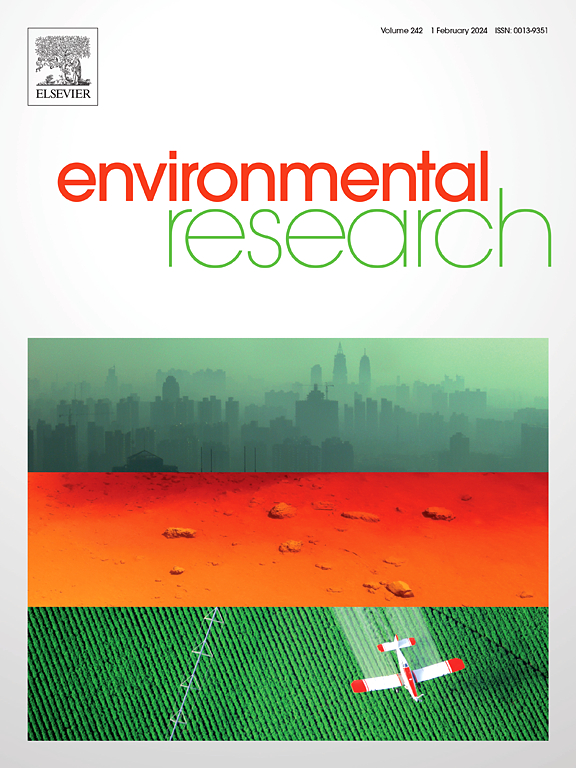挪威环境生物库中儿童饮食模式与环境污染物之间的关系:横断面分析。
IF 7.7
2区 环境科学与生态学
Q1 ENVIRONMENTAL SCIENCES
引用次数: 0
摘要
众所周知,饮食是环境污染物的来源。这项横断面研究探讨了挪威环境生物库中儿童的饮食模式及其与污染物暴露的关系。父母填写的问卷提供了儿童摄入36种食物和饮料的频率以及社会人口统计数据。在儿童的尿液、血浆和全血中测量了几种环境污染物。数据来自658名7-14岁的儿童。使用数据驱动因子分析确定了两种饮食模式,分别表示为“健康”和“不健康”。我们使用线性回归检查了儿童饮食模式和污染物浓度之间的关系,并根据参与者的特征进行了调整。健康模式与血浆全氟壬酸盐(PFNA)浓度呈正相关,而不健康模式与尿双酚A (BPA)浓度呈正相关。采用广义线性模型泊松回归检验超过健康指导值(HBM-GV)的可能性。四种最常见的单氟烷基和多氟烷基物质(Ʃ4PFAS)的总数随着健康模式得分的增加而增加,每个标准差的相对风险(RR)为1.18 (95% CI: 1.06, 1.31)。多元回归分析显示,鸡蛋和鱼/贝类的摄入量与较高的Ʃ4PFAS相关,每增加一周的摄入量,浓度分别增加4%和5% (P本文章由计算机程序翻译,如有差异,请以英文原文为准。
Associations between dietary patterns and environmental contaminants in children from the Norwegian Environmental Biobank: A cross-sectional analysis
Diet is a well-known source of environmental contaminants. This cross-sectional study explored children's dietary patterns and their association with contaminant exposure in the Norwegian Environmental Biobank. Parent-completed questionnaires provided data on children's frequency of intake of 36 foods and beverages, and socio-demographics. Several environmental contaminants were measured in urine, plasma, and whole blood from the children. Data were available for 658 children aged 7–14 years. Two dietary patterns, denoted "healthy" and "unhealthy," were identified using data driven factor analysis. We examined associations between child dietary patterns and contaminant concentrations using linear regression, adjusting for participant characteristics. The healthy pattern was positively associated with plasma perfluorononanoate (PFNA) concentration, whereas the unhealthy pattern was positively associated with urinary bisphenol A (BPA) concentration. Likelihood of exceeding health-based guidance value (HBM-GV) was examined using generalized linear model Poisson regression. The sum of the four most prevalent per- and polyfluoroalkyl substances (Ʃ4PFAS) increased with higher healthy pattern scores, with a relative risk (RR) of 1.18 (95 % CI: 1.06, 1.31) per standard deviation. Multiple regression analyses showed that egg and fish/shellfish consumption were associated with higher Ʃ4PFAS, with 4 % and 5 % higher concentrations per additional weekly serving, respectively (P < 0.001). For the sum of urinary di(isononyl)cyclohexane-1,2-dicarboxylate (ƩDINCH), 10 % higher concentration was observed per weekly serving of sweets/desserts. The urinary BPA concentration was 3 % higher per extra weekly serving of fruit juice (P = 0.001). These results highlight the need for societal measures to reduce contaminant exposure through food.
求助全文
通过发布文献求助,成功后即可免费获取论文全文。
去求助
来源期刊

Environmental Research
环境科学-公共卫生、环境卫生与职业卫生
CiteScore
12.60
自引率
8.40%
发文量
2480
审稿时长
4.7 months
期刊介绍:
The Environmental Research journal presents a broad range of interdisciplinary research, focused on addressing worldwide environmental concerns and featuring innovative findings. Our publication strives to explore relevant anthropogenic issues across various environmental sectors, showcasing practical applications in real-life settings.
 求助内容:
求助内容: 应助结果提醒方式:
应助结果提醒方式:


